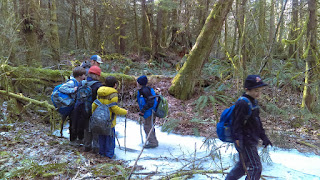The Black-Tailed Deer met last Sunday for their first winter exploration together as a group. Our outing came at the tail end of a two week cold spell and this was our first chance to see what the woods look, smell, sound and feel like during the icy grip of a winter freeze. In addition to exploring in the winter for the first time, this was also the first BEC exploration in this spot ever! We were tasked by BEC to scout this spot and decide whether or not it would be a good place to come back to with other groups.
 |
| Frozen streams! |
We started our day by traveling through a section of very disturbed forest. We noticed lots of blackberry and english ivy, both plants that we recognized as invasive because we had spent time getting rid of them at our service site on Connelly Creek. In search of a healthier patch of wood, we pressed on into unknown territory.
We eventually came to a gravel path, and on the other side we began to recognize a healthier forest. Tall cedars and hemlocks reached skyward and jockeyed for any available sunlight in the canopy. Instead of blackberries and ivy on the forest floor, here there were sword ferns and huckleberry bushes. We could hear the sound of running water in the distance and we let our ears lead us toward the gurgling brook.
Upon reaching the small stream, we noticed a great variety in the thickness of the ice in different places. The mentors told us that this is because water freezes more readily when it is moving slow or not at all, and in areas of swift water, the ice would be very thin. Normally, getting our feet a little wet in a creek was not a big deal in BEC, but the mentors explained to us the new danger of getting wet in such cold weather and how it could lead to hypothermia. After acknowledging these risks, our inner curiosity took over and compelled us to move onto the ice and begin to explore this frictionless world.
We managed to play on the ice for over an hour before one of us found himself ankle deep in cold running water. Luckily, this explorer had packed extra wool socks, a must on a cold winter exploration. As this explorer was changing into dry socks, another one of us found our way into the water! Sometimes we just have to make our own mistakes in order to really come to understand something. Fortunately, this water was just deep enough to effectively chill our feet and teach us a lesson.
At this point, the mentors thought it wise to move on from the ice. We let our inner vision guide us to a good spot for spiders web. We found a suitable spot and sat down for a snack before we playing our first game.
 |
| Snack time/pig pile |
We were only a group of seven today, including the mentors. While we were playing spiders web, we realized that this gave a huge advantage to the spider as he had less flies to keep track of. In a rare turn of events, the spider actually won two games in a row by successfully returning all of the flies to the web!
 |
| Can you spot the explorer in this picture? |
Seeing that our spring season focus is Tracking and Bird Language, the mentors thought it would be a good idea to have a sit spot to end the day and see if we could begin notice some of the bird language in the forest. This sit spot also allowed us to come to know this forest a bit better as this was a new patch of woods after all.
After our sit spot, we had our usual closing circle where we shared gratitude and apples. Back at the cars where our parents were waiting for us, we agreed that these new woods were a great spot to explore and that they likely hold many more unknown and interesting spots that future BEC groups could come and discover.




